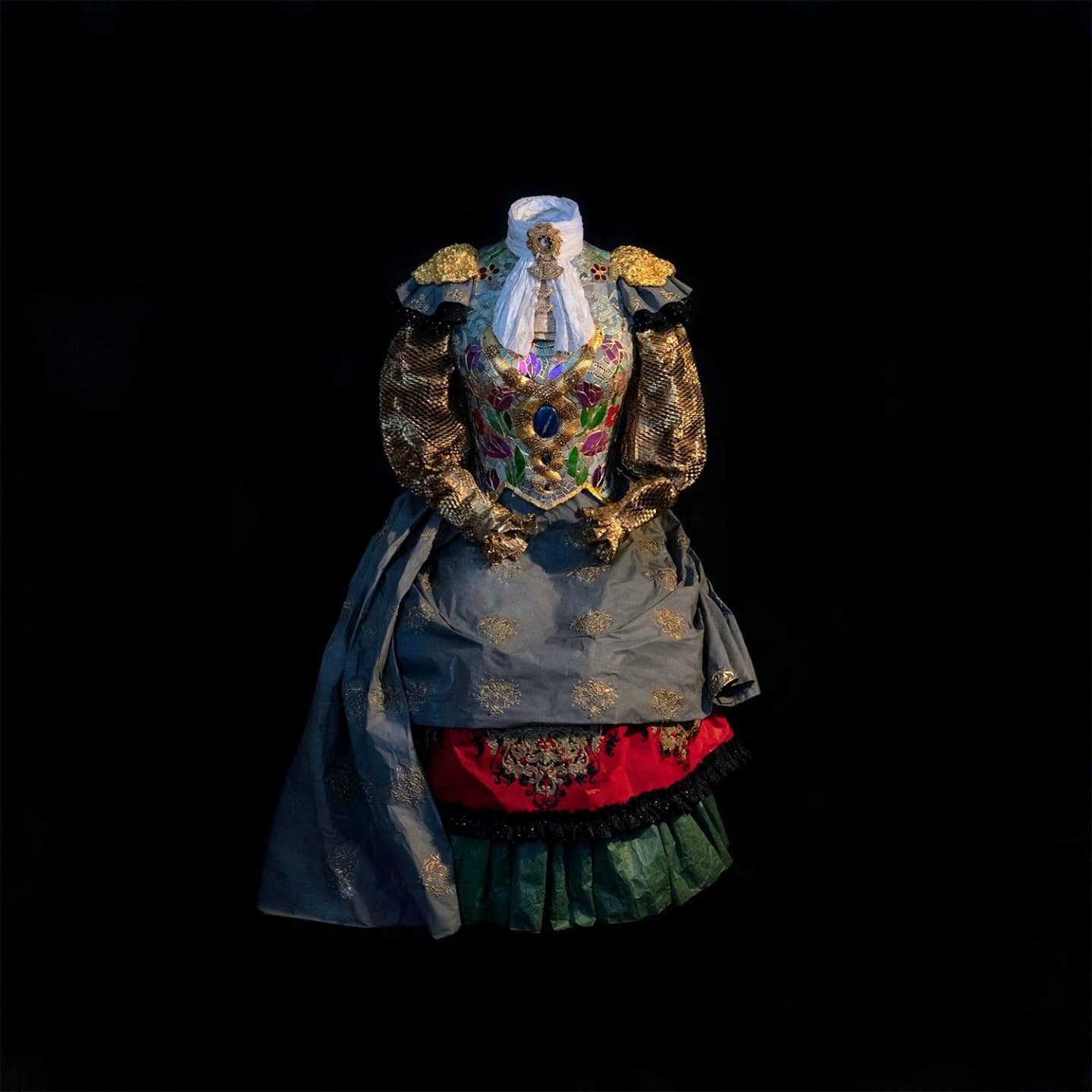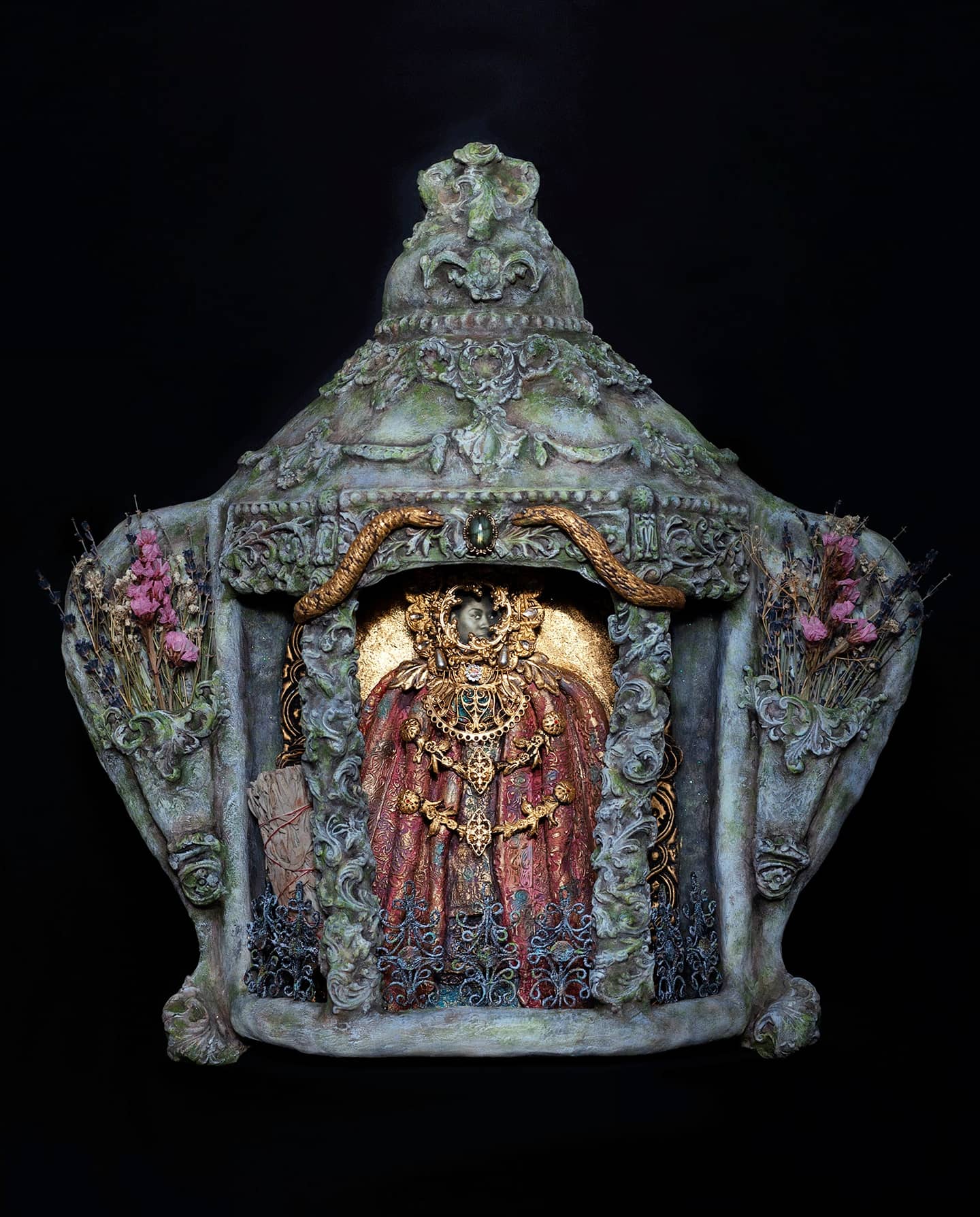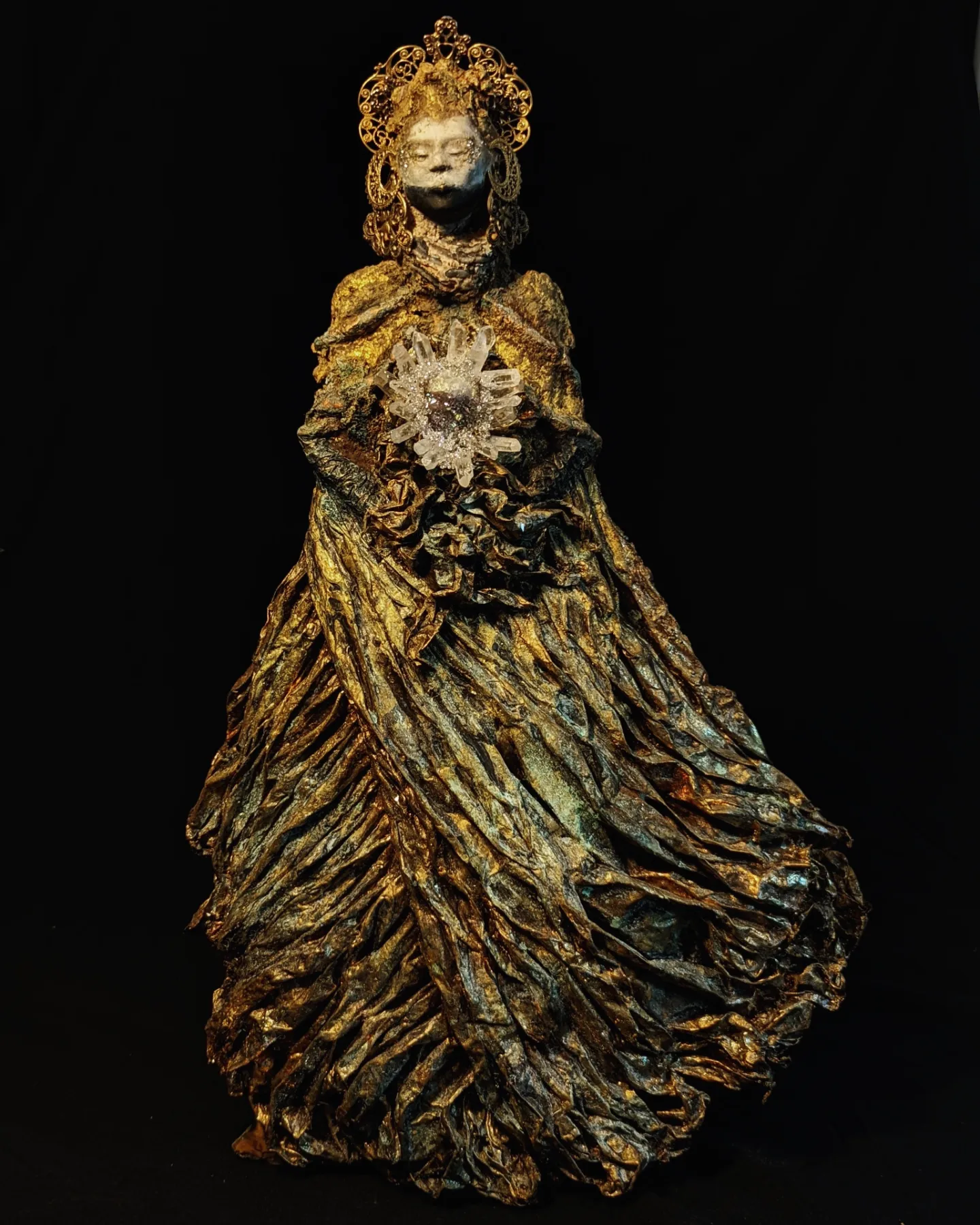Interview with the Artist Fabiola Jean-Louis
PDF: Valance and Zhurauliova, Interview with Fabiola Jean-Louis
Hélène Valance and Tatsiana Zhurauliova: Recently, many institutions have been attempting to cultivate a more inclusive approach to curating and display. The Metropolitan Museum of Art’s Before Yesterday We Could Fly installation, which included your work (fig. 1), is a striking manifestation of that. This is a great step in making up for institutional erasure, and the urgency of such intervention is clear, but why do you think so many of these interventions revolve around alternative approaches to temporality?
Fabiola Jean-Louis: I think this interest in temporality has existed for a long time. Black people and people of color have always had to, by default, imagine different realities of existence, because of the trauma surrounding racism and injustice, and because such simple things as freedom and the right to live have been constantly threatened for them. When you are in a space of constant trauma and violence, you are naturally going to try to remove oneself somehow—virtually, mentally, or emotionally—from that trauma so that you can deal with it. I think that this is inherently a part of us: it’s not just such contemporary artists as Titus Kaphar, Sonya Clark, or Renée Cox who do this work, I think it is just human nature. I think this is happening in Black art because it’s so very much a part of who we are and how we navigate trauma.
Another reason is that if we do not go back, if we do not think about time as memory—that is also what history is, history is also memory—if we do not take another look at what history has taught us, and we do not acknowledge the parts that are false about the narratives that are being told about history, then space is not claimed, then it’s almost as if we didn’t exist, and the truth is not the truth. And we can only imagine how that impacts the present and the future. These problems of race and identity that we are dealing with will never be dealt with. This is why it’s important to go back in time and expose those things—and that is what I Iove so much about Kaphar’s work. His work does that literally, physically; it exposes the parts of history that normally are not talked about. But that is part of the healing. Curators and artists understand that to heal and to have a better understanding of where we go in the future, we have to go to the past, to deal with those truths.

HV and TZ: You describe yourself as a time traveler: what does that mean for you?
FJL: I consider that I do not exist in one time-space: even if I am very present in this specific moment, of which I am very aware, I am also very aware that I am pulling from different things that are not necessarily happening right now. And that is the way that I create: my process is drawing on so many different things across time to be able to affect the person who is looking at my work. Because of the multiple dimensions of our sensory perception, I am constantly thinking about how I can stimulate all of our five senses. For me, the answer is by using time. Maybe it’s something that we think we smelled or something we saw or felt—anything that will make us interested in something, and we do not even know why. I need the power of time to do that.
HV and TZ: Beyond the concept of time, the very process of art making seems very important to your work. Can you tell us more about the temporality of your artistic practice? How do you experience it? How does temporality shape the works themselves?
Also, you mostly work with paper, which is an ephemeral and fragile material, but in your work, you combine it with more lasting and precious ones, such as gold and gems. How does this ephemeral dimension fit with the various temporalities that you explore in your work?
FJL: Time can be a very abstract idea, which you can take very far. But there is also an important nuance that distinguishes the concepts of time and temporality: you can see time as just an abstract thing that we think we understand or have some grasp of, and (not but) we can also think of time not just as this abstraction but as what is actually happening within time—which is how I read temporality. To me, time is the length, the span, while temporality is made of the elements and events contained in that span. My work, first, takes a long time—everything takes time. It’s not just creating the setting, painting it, which maybe can be done in a week. My work is made of many different elements, and each step relies on time before I can bring everything together to make one piece (fig. 2). But then, as you mentioned, time is also part of my work because this material, paper, theoretically is not supposed to last very long; it is ephemeral. As I am making my works, I am thinking about how time will impact this material, how different materials like stones and crystals and paper will interact with one another. If I put a stone in the center of all this paper, let’s say three hundred years from now, will it be the only thing to remain, and will the rest of the story will be gone? So I am always thinking of ways to push the story past just the paper because I know the material that I am working with may not last. There is, of course, a chance that the paper work that I am making will last; it might actually last for a very long time—there are scrolls that have survived for centuries—but I do not know that. And that uncertainty also belongs to the time-capsule aspect of my current project.

HV and TZ: You often document “behind the scenes” of your process on social media, and it is fascinating and deeply enjoyable to watch you go through different stages of making your pieces. Do you think the “time traveling” idea also applies to your process: being present in the making but also being in the future, imagining the final shape of the work?
FJL: I am part in the future when I am making, but it is a very complex thing because I need to find a subtle balance between temporalities. If I am too much in the future, then I am not being present for the messages that I am getting at that moment for how that piece should turn out. When I say “messages,” I mean them as both spiritual and intuitive, and I have to be present for those things to come through. So I try not to go too far into the future when I am working, because presence is so important to be able to feel or to understand what my intuition is telling me. It does not mean that I am not going to get something wrong (wrong is maybe not the appropriate word here, because there are no real mistakes in my process, since everything that I create, even the things that I do not like, become learning opportunities). The contrast between the mushy paper pulp I start with and the gilded object with gold and wax that I create in the end is a reflection of all the time that it has taken to just be in that space of making and to just say, “Okay, what do you want to be?” There’s only so much that I will do sometimes, and there’s a part when I am imposing myself onto the thing, and then there’s a time when I am pulling myself away from it, and I am saying, “Now you have to tell me where you want to go”. At the end, there’s this constant conversation between me and the object.
HV and TZ: Can you tell us more about your current project and how it connects to the idea of temporality? In particular, could you elaborate on the importance of the concept of relic for this project?

FJL: What I am creating is a columbarium: a structure made of many niches that would usually be situated underneath a mausoleum or a church. The niches were made for either the ashes of one’s loved ones or for some of their belongings, as a way to hold space and memory for them. This work is very much centered on memory (yet another form of time travel), but what it specifically looks at is spirituality and rootedness, because those were things that we were forced to give up when we were enslaved. Being able to plant your feet on the ground, sing and dance, and commune with our ancestors was the first thing that was taken away from us, because it was a source of power. The importance of religion is in its spiritual aspect, in the way that it is a fundamental part of humanity. Our spirituality was taken away from us to strip us of the ability to even feel human. Through that history, we have reached a point where Christianity now has replaced other spiritual practices within Black communities—there are more Black Christians in America than there are Black communities practicing vodou and root magic. This project then is partially about history and partially about having a conversation about what Black freedom looks like from the point of view of spirituality, because vodou is said to have been a crucial element in the Haitian revolution.1 Vodou ceremonies that called on the Lwas were performed before the revolution, and it was the power of that spirituality that helped Haitians win. But it is not something that we talk about, and we do not often talk about how that type of spirituality has helped us survive throughout time.
These ideas are the basis for the project. The centerpiece of the project is a relic (fig. 3), which will be at the very center of the space in a room filled with niches. Everything is going to be made out of paper pulp and stones. There will be two figures on each side of the relic, and people may not realize it when looking at it, but the relics and those two figures form a triangle that creates a ritual space for the kind of spirituality I describe above. The project includes collaboration with local students, who are creating sculptures for the niches: “time capsules,” or they can also be described as vessels for this ritual. As the exhibition moves from one venue to another, it will evolve, further continuing the conversation about spirituality, ritual, memory, and freedom.
Cite this article: Hélène Valance and Tatsiana Zhurauliova, “Interview with the Artist Fabiola Jean-Louis,” in “About Time: Temporality in American Art and Visual Culture,” In the Round, ed. Hélène Valance and Tatsiana Zhurauliova, Panorama: Journal of the Association of Historians of American Art 8, no. 2 (Fall 2022), https://doi.org/10.24926/24716839.15049.
Notes
- See, for example, Crystal Nicole Eddins, Rituals, Runaways, and the Haitian Revolution (Cambridge: Cambridge University Press, 2021). ↵
About the Author(s): Fabiola Jean-Louis is a conceptual artist working in paper sculpture, photography, paper textiles, installation, and painting. Hélène Valance is an associate professor at the Université de Franche-Comté and scientific advisor at the Institut National d’Histoire de l’Art. Tatsiana Zhurauliova is an associate researcher at Université Paris 1 Panthéon-Sorbonne.

